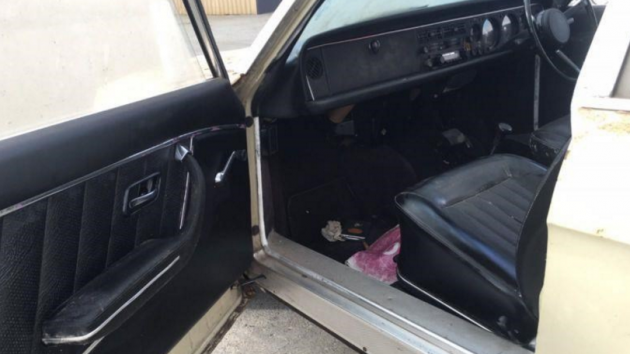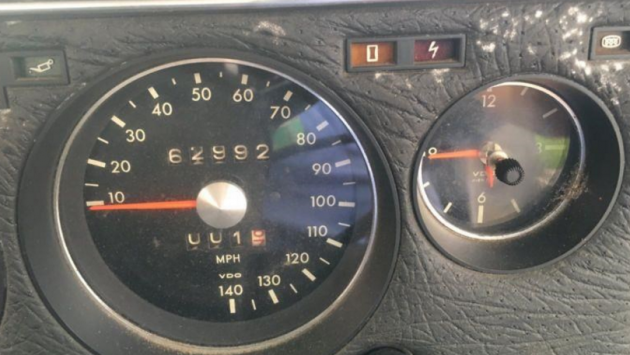The NSU Ro80 has been an automotive curiosity since it was new, featuring a rotary powerplant, a semiautomatic transmission and styling that was ahead of its time. However, a reputation for unreliability limited the car’s potential when new, and financial struggles limited the company’s prospects. Still, they are coveted by NSU enthusiasts today, and this 1975 model here on TradeUniqueCars is a barn-fresh example ready for restoration.
The NSU’s rotary engine was novel but troublesome, and the lack of understanding of the complex design by your average 1970s mechanic didn’t help spur favorable outcomes. The body was handsome, and quite different from its American contemporaries at the time. It’s no surprise the design team would later find homes at companies like BMW, where the upright, boxy styling would define the company’s cars for years to come. While filthy, this Ro 80 doesn’t appear rusty.
The interior presents well, with undamaged door panels and seats holding up to years of neglect. If those are leather seats, that’s one of the rarer options available on an Ro 80, which typically featured cloth buckets. The seller does acknowledge that the interior needs a good cleaning and there are some small areas of isolated rust. Bodywork is evident on the front left quarter. In addition to the rotary motor, the NSU’s also featured fully independent suspension with disc brakes at all four corners – which was truly unique for an ordinary sedan.
Watch any videos of the NSUs on YouTube and close your eyes: sounds like an RX7 is firing up, doesn’t it? The range of features that these stately sedans incorporated as standard equipment, along with the clever packaging and engineering feats, certainly make the Ro 80 one of the more memorable imports from the 1970s. Its reliability issues shouldn’t deter you if you’re handy with rotaries or have a mechanic who is; but buying a barn find example without a trusted resource for a rebuild would be risky at best. Have any of you ever driven an Ro 80?






I drove a Ro 80 in Germany quite a few years ago, and quite enjoyed it. Well, I enjoyed it for the most part, as I never got completely comfortable with the “automatic” gearbox (think VW “Automatic Stick Shift”). It didn’t seem quite as quick as my Mazda RX-3, but was certainly capable of keeping up with German traffic. It handled and rode very well, was beautifully built, and the engine was of course as smooth as glass.
Seems to me it might be somewhat difficult to get parts for. Not many NSU dealers around these days! Or, for that matter, VW dealers who would have parts for a VW K70, which was essentially a Ro 80 with a VW piston engine.
I wonder if there is a leg attached to that shoe under the driver front wheel.
THIS is why i love this website! I never have seen or heard of these cars b4, thanks BF
There’s were considered quite advanced in their day. It’s a shame that the Ro80 had so many reliability issues.
Amazing find; thanks for sharing.
My cousin’s sister in law has her father’s Ro80 that is in the process of being restored. My cousin has his Wankel Spider that’s in the same color as the Ro80 posted
I didn’t realize that was considered a color.
There’s my shoe!
Cool, it has a FARHT START- not that I need one.
Very handsome from the front!
The issues with the Ro80 were solved early on when NSU issued a recall to replace engines. Essentially the rotor tip seals were too thin and it was solved by making them thicker. The recall all but bankrupted NSU and led to Audi’s buy out. This car truly was Claus Luthe’s masterpiece. The Saxomatic 4spd isn’t a bad trans and wasn’t troublesome as VW’s Auto Stick or Porsche’s Sportmatic. I’d buy this thing in a heartbeat… There are a couple companies in Germany that still make most of the parts.
I own a nice example need a rebuild on the engine, anyone know of a facility that can rebuild the engine?
NSU quite willingly admitted that the relied on Mazda’s work as well. A condition of the Wankel licensing agreement was that any technology improvements were reported back. For a while there, quite a few companies were licensing Wankel rotary tech. GM, Citroen,Mercedes Benz, Curtiss Wright, and Norton all researched it. Citroen,in a joint venture with NSU, was the only other manufacturer to make production other than the people who really mastered and perfected the design, Mazda.
For much of the time they have been available, the NSU engines weren’t worth much, it was hard to tell if you had a good one once out of the car.
But once sorted, the NSU motors were quite reliable, I know of a car with 100,000 miles on the original motor, it still pulls smoothly and doesn’t smoke, and yes, through the owners clubs parts are still being made.
This Ro80 is coveted by NSU enthusiasts today? You mean, all three of them? Hans, Franz, and Wilhelm can fight over this one!
Apparently you are unfamiliar with the Prinz and another, slightly more famous NSU called the TT
more French-lookin 2 me than German
They are very aerodynamic, like Citroens.
Claus Luthe,(1932-2008) the designer, was a very talented man and easily one of the top twenty designers worldwide. While still at Audi-NSU he designed the K70 sister car, the real reason VW bought NSU was to get the K70, launched as the VW K70, the first FWD VW. He left Audi for BMW who wanted a fresher look and someone who knew aerodynamics.
At BMW he designed the conversion of the E12 into the E28, 5 series, then the E30, E31, E33, E34, E36, So pretty much all of the good looking BMWs through the 80s and 90s before BMW Bangled up the design part.
His life was marked with tragedy when he was charged with murdering his drug addict son, after an argument, and was convicted for manslaughter. He got a very lenient sentence and later came back into design as a consultant.
I worked on a Ro80 in a body repair shop in Glasgow, Scotland way back in the 1970s, took it for a short drive road test when the job was complete. That was my one and only experience with Ro80s.
Might want to mention the car is on the other side of the planet from most of the readers here, it’s in Bangholme Australia!
I remember the first one of these I saw, in ’67. I thought it was the most beautiful 4 dr I had ever seen. It doesn’t look radical now, because others followed that look, but think of what other cars looked like in 1967–it was radical.
I always liked NSUs. But never had a chance to drive one.
Someday maybe.
Neighbor in Germany had one- so imagine a tall, lanky Texan driving one around in central West Germany…cowboy hat & all.
Rode in it several times, liked the car. Too young to drive, so never experienced that part
I’ve had a few of these many years ago. But the early models suffer rust of 60s Italian or even BMW E3 proportions, specially when fitted with a sunroof, or metallic paint, and my first Ro80, fitted with both, succumbed quite quickly to rust. These and earlier Audis are why Audi brought in galvanised steel and then aluminium construction. My second Ro80 had all these problems as well but had been retro-fitted with The Worst Engine Ever, Ford’s horrible iron V4. I quickly sold it on.
Later I looked at buying an Ro80 with a very good 13B Mazda conversion and I was very impressed, it was much quicker, (140 mph), and no more thirsty. But it coincided with a house purchase which took precedence. I regret the non purchase still. The Mazda conversion is fairly straightforward, but there are a few tricks to ensuring transmission longevity, despite that the conversion is common.
They drive really well. The steering, in particular, is very, very good, better than most cars even up to today. One of the earlier European power steering efforts, it’s so much better than the steering in later Audis that it’s hard to believe that they’re from essentially the same company, (the RO80 along with the (freak?) notable exception of the later Ur Quattro marked a real highlight, before a return to steering wooden-ness again, probably not helped by wider tyres)
Mercedes Benz’s budget brand, Audi, was sold to VW, in 1964, shortly after being restarted, VW bundled it in with it’s NSU purchase, and since then has assiduously pushed it upmarket. The new company was actually called ‘Audi NSU Auto Union AG’ right through until 1985, well after the last one of these was made, when it became named just ‘Audi AG’, and the plant in Neckersulm is where Audi’s A6, A8, R8, and indeed all their aluminium cars are still made. ( And where Audi 100s, 200s/5000s and Porsche 924s and 944s were made as well.)
Even without the rotary, these would have been 1968 European Car of the Year, because of the other features of the car. A very spacious interior, excellent brakes, well developed long travel strut suspension giving Citroenesque ride and neutral well balanced handling, class leading aerodynamics,( for the time a Cd of 0.35 was the best you could get, the same as a Citroen SM) ,and the quiet cruising and relatively high speed that eventuated from that. It might have helped the fuel consumption too but it was a rotary so any mitigation was slight. I do remember comparing notes with Mazda RX2 and RX3 owners, their much smaller cars got about the same low or sub 20s mpg.
They look and handle better with the optional Fuchs forged alloys which are incredibly light and these help the handling as well.
These cars are like the Citroen ID/DS, or SM, the Corvair, the Rover P6 ,the first Mini, or the Tesla S in being epochal cars that were beyond their time and represented high points in design and technology. If you ever get the chance to drive one or even own one, you should.
At some stage I will have another one.
From Australia, owned one for 12 years. At 130,000 miles the compression was too low to start it. Until then it never missed a beat. Crossed the Nullabor (Perth to Sydney) twice, averaged 26 MPG at 80MPH.
Converted to Mazda 12A rotary but, although power was transformed, it became ‘agricultural’ in feel and fuel consumption down to 18-20MPG
Love another one!